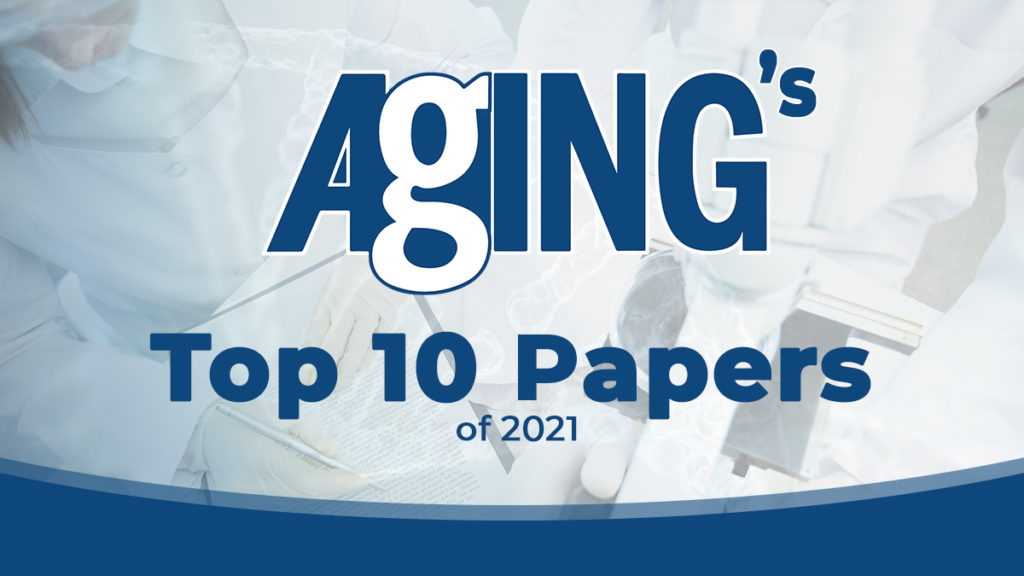
Read the 10 most-viewed papers on Aging-US.com of 2021.
—
#10: Iron: an underrated factor in aging
Author: Dennis Mangan
Institution: MTOR LLC
Quote: “Blocking iron absorption through drugs or natural products extends lifespan. Many life-extending interventions, such as rapamycin, calorie restriction, and old plasma dilution can be explained by the effects they have on iron absorption, excretion, and metabolism.”
#9: Reversal of cognitive decline: A novel therapeutic program
Author: Dale E. Bredesen
Institutions: University of California Los Angeles and Buck Institute for Research on Aging
Quote: “This report describes a novel, comprehensive, and personalized therapeutic program that is based on the underlying pathogenesis of Alzheimer’s disease, and which involves multiple modalities designed to achieve metabolic enhancement for neurodegeneration (MEND).”
#8: Shorter telomere lengths in patients with severe COVID-19 disease
Authors: Raul Sanchez-Vazquez, Ana Guío-Carrión, Antonio Zapatero-Gaviria, Paula Martínez, and Maria A. Blasco
Institutions: Spanish National Cancer Research Center – CNIO and Field Hospital COVID-19, IFEMA
Quote: “The incidence of severe manifestations of COVID-19 increases with age with older patients showing the highest mortality, suggesting that molecular pathways underlying aging contribute to the severity of COVID-19. One mechanism of aging is the progressive shortening of telomeres, which are protective structures at chromosome ends.”
Authors: Ronit Shapira, Amos Gdalyahu, Irit Gottfried, Efrat Sasson, Amir Hadanny, Shai Efrati, Pablo Blinder, and Uri Ashery
Institutions: Tel Aviv University and Assaf Harofeh Medical Center
Quote: “Hyperbaric oxygen therapy (HBOT) is in clinical use for a wide range of medical conditions. In the current study, we exposed 5XFAD mice, a well-studied AD model that presents impaired cognitive abilities, to HBOT and then investigated the therapeutical effects using two-photon live animal imaging, behavioral tasks, and biochemical and histological analysis.”
Authors: Anna Kovalchuk, Bo Wang, Dongping Li, Rocio Rodriguez-Juarez, Slava Ilnytskyy, Igor Kovalchuk, and Olga Kovalchuk
Institutions: Pathway Research Inc., University of Calgary and University of Lethbridge
Quote: “Cannabis sativa has been proposed to modulate gene expression and inflammation and is under investigation for several potential therapeutic applications against autoinflammatory diseases and cancer. Here, we hypothesized that the extracts of novel C. sativa cultivars may be used to downregulate the expression of pro-inflammatory cytokines and pathways involved in inflammation and fibrosis.”
Authors: Rebecca Robbins, Stuart F. Quan, Matthew D. Weaver, Gregory Bormes, Laura K. Barger, and Charles A. Czeisler
Institutions: Brigham and Women’s Hospital, Harvard Medical School and Boston College
Quote: “Sleep disturbance and deficiency are common among older adults and have been linked with dementia and all-cause mortality. Using nationally representative data, we examine the relationship between sleep disturbance and deficiency and their risk for incident dementia and all-cause mortality among older adults.”
Authors: Oleksandr Demidenko, Diogo Barardo, Valery Budovskii, Robb Finnemore, Francis R. Palmer III, Brian K. Kennedy, and Yelena V. Budovskaya
Institutions: TruMe Inc., National University Singapore, Ponce de Leon Health, National University Health System Singapore, and Singapore Institute for Clinical Sciences, A*STAR
Quote: “Instead, aging biomarkers, such as DNA methylation (DNAm) clocks, have been developed to monitor biological age. Herein we report a retrospective analysis of DNA methylation age in 42 individuals taking Rejuvant®, an alpha-ketoglutarate based formulation, for an average period of 7 months.”
#3: Aging and rejuvenation – a modular epigenome model
Authors: Priscila Chiavellini, Martina Canatelli-Mallat, Marianne Lehmann, Maria D. Gallardo, Claudia B. Herenu, Jose L. Cordeiro, James Clement, and Rodolfo G. Goya
Institutions: National University of La Plata, National University of Cordoba, World Academy of Art and Science (WAAS), and Betterhumans Inc.
Quote: “The view of aging has evolved in parallel with the advances in biomedical sciences. Long considered as an irreversible process where interventions were only aimed at slowing down its progression, breakthrough discoveries like animal cloning and cell reprogramming have deeply changed our understanding of postnatal development, giving rise to the emerging view that the epigenome is the driver of aging.”
Authors: Kara N. Fitzgerald, Romilly Hodges, Douglas Hanes, Emily Stack, David Cheishvili, Moshe Szyf, Janine Henkel, Melissa W. Twedt, Despina Giannopoulou, Josette Herdell, Sally Logan, and Ryan Bradley
Institutions: Institute for Functional Medicine, American Nutrition Association, National University of Natural Medicine, Ariel University, McGill University, and University of California San Diego
Quote: “Manipulations to slow biological aging and extend healthspan are of interest given the societal and healthcare costs of our aging population. Herein we report on a randomized controlled clinical trial conducted among 43 healthy adult males between the ages of 50-72.”
Authors: Yafit Hachmo, Amir Hadanny, Ramzia Abu Hamed, Malka Daniel-Kotovsky, Merav Catalogna, Gregory Fishlev, Erez Lang, Nir Polak, Keren Doenyas, Mony Friedman, Yonatan Zemel, Yair Bechor, and Shai Efrati
Institutions: Shamir Medical Center, Tel Aviv University and Bar Ilan University
Quote: “At the cellular level, two key hallmarks of the aging process include telomere length (TL) shortening and cellular senescence. Repeated intermittent hyperoxic exposures, using certain hyperbaric oxygen therapy (HBOT) protocols, can induce regenerative effects which normally occur during hypoxia. The aim of the current study was to evaluate whether HBOT affects TL and senescent cell concentrations in a normal, non-pathological, aging adult population.”
Click here to read the latest papers published by Aging.
AGING (AGING-US) VIDEOS: YouTube | LabTube | Aging-US.com
—
Aging (Aging-US) is an open-access journal that publishes research papers bi-monthly in all fields of aging research. These papers are available to read at no cost to readers on Aging-us.com. Open-access journals offer information that has the potential to benefit our societies from the inside out and may be shared with friends, neighbors, colleagues, and other researchers, far and wide.
For media inquiries, please contact [email protected].